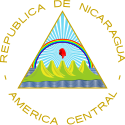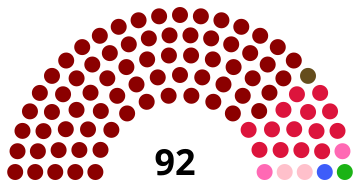2016 Nicaraguan general election
| ||||||||||||||||||||||||||||||||||||||||||||||||||||||
|
| ||||||||||||||||||||||||||||||||||||||||||||||||||||||
Presidential election | ||||||||||||||||||||||||||||||||||||||||||||||||||||||
| ||||||||||||||||||||||||||||||||||||||||||||||||||||||
 Results by department Ortega : 50–60% 60–70% 70–80% 80–90% | ||||||||||||||||||||||||||||||||||||||||||||||||||||||
| ||||||||||||||||||||||||||||||||||||||||||||||||||||||
90 seats in the National Assembly 46 seats needed for a majority | ||||||||||||||||||||||||||||||||||||||||||||||||||||||
This lists parties that won seats. See the complete results below.
| ||||||||||||||||||||||||||||||||||||||||||||||||||||||
 |
|---|
|
|
General elections were held in Nicaragua on 6 November 2016 to elect the President, the National Assembly and members of the Central American Parliament.[1] Incumbent President Daniel Ortega of the Sandinista National Liberation Front (FSLN) was re-elected for a third consecutive term amid charges he and the FSLN used their control of state resources to bypass constitutional term limits and hamstring political rivals. The FSLN benefited from strong economic growth and relatively low levels of crime compared to neighbouring countries.[2]
According to the official results, Ortega was reelected with more than 70% of the votes. However, the election was questioned by the opposition due to the dismissal of sixteen opposition deputies months prior to the election and the complaints of both electoral fraud and voter intimidation.[2]
Background
Four months before the elections, the Nicaraguan Supreme Court removed the disputed Independent Liberal Party (PLI) leader Eduardo Montealegre from office, decreeing that Pedro Reyes was the leader of the PLI. After 16 deputies from the PLI and its Sandinista Renovation Movement ally objected, the Supreme Electoral Council ordered them removed from the National Assembly and empowered Reyes to select their replacements.[3][4][5][6]
Electoral system
The president was elected using first-past-the-post voting.[7]
The 90 elected members of the National Assembly were elected by two methods; 20 members were elected from a single nationwide constituency, whilst 70 members were elected from 17 multi-member constituencies ranging in size from 2 to 19 seats. Both types of election were carried out using closed list proportional representation with no electoral threshold.[8] A further two seats were reserved for the runner-up in the presidential election and the outgoing president (or their vice president).[9]
Lists of candidates to the National Assembly and to the Central American Parliament had to be composed of 50% male and 50% female candidates.[10]
Conduct
In June 2016 Ortega announced international observers would not be allowed to oversee the elections. The Carter Center termed this "an attack on the international community... We...lament this decision to ignore a key portion of Nicaragua's own electoral law."[11] However, less than two weeks before the elections, the Organization of American States accepted an invitation to send a delegation "to meet with experts and state bodies involved in the electoral process" from 5–7 November.[12][13]
According to the official results, Ortega was reelected with more than 70% of the votes. However, the election was questioned by the opposition due to the dismissal of the opposition deputies, the lack of international observers and the complaints of both electoral fraud and voter intimidation.[2]
Results
President
Ortega was widely expected to win due to the popularity of his social programmes and because he faced no obvious political challenger.[14]
| Candidate | Party | Votes | % | |
|---|---|---|---|---|
| Daniel Ortega | Sandinista National Liberation Front | 1,806,651 | 72.44 | |
| Maximino Rodríguez | Constitutionalist Liberal Party | 374,898 | 15.03 | |
| José Alvarado | Independent Liberal Party | 112,562 | 4.51 | |
| Saturnino Cerrato | Nicaraguan Liberal Alliance | 107,392 | 4.31 | |
| Erick Cabezas | Conservative Party | 57,437 | 2.30 | |
| Carlos Canales | Alliance for the Republic | 35,002 | 1.40 | |
| Total | 2,493,942 | 100.00 | ||
| Valid votes | 2,493,942 | 96.51 | ||
| Invalid/blank votes | 90,246 | 3.49 | ||
| Total votes | 2,584,188 | 100.00 | ||
| Source: CSE, IFES | ||||
National Assembly
 | |||||||||
|---|---|---|---|---|---|---|---|---|---|
| Party | National | Constituency | Total seats | +/– | |||||
| Votes | % | Seats | Votes | % | Seats | ||||
| Sandinista National Liberation Front | 1,590,316 | 65.86 | 14 | 1,608,395 | 65.62 | 56 | 70 | +8 | |
| Constitutionalist Liberal Party | 369,342 | 15.30 | 3 | 375,432 | 15.32 | 10 | 13 | +11 | |
| Independent Liberal Party | 162,043 | 6.71 | 1 | 117,626 | 4.80 | 1 | 2 | –24 | |
| Nicaraguan Liberal Alliance | 137,541 | 5.70 | 1 | 137,078 | 5.59 | 1 | 2 | +2 | |
| Conservative Party | 106,027 | 4.39 | 1 | 110,568 | 4.51 | 0 | 1 | +1 | |
| Alliance for the Republic | 49,329 | 2.04 | 0 | 70,939 | 2.89 | 1 | 1 | +1 | |
| YATAMA | 30,901 | 1.26 | 1 | 1 | +1 | ||||
| Special members[a] | 2 | – | |||||||
| Total | 2,414,598 | 100.00 | 20 | 2,450,939 | 100.00 | 70 | 92 | 0 | |
| Source: CSE, El 19 Digital | |||||||||
- ^ The runner-up in the presidential election (Maximino Rodríguez of the Constitutionalist Liberal Party) and the outgoing president are special members of the National Assembly; as Ortega was re-elected, outgoing Vice President Omar Halleslevens of the FSLN, who was not Ortega's running mate in these elections (having been replaced by Rosario Murillo), will take up his seat.
List of elected deputies
- ^ a b The runner-up in the presidential election (Maximino Rodríguez of the Constitutionalist Liberal Party) and the outgoing president are special members of the National Assembly; as Ortega was re-elected, outgoing Vice President Omar Halleslevens of the FSLN, who was not Ortega's running mate in these elections (having been replaced by Rosario Murillo), will take up his seat.
Central American Parliament
| Party | Votes | % | Seats | +/– | |
|---|---|---|---|---|---|
| Sandinista National Liberation Front | 1,673,627 | 68.45 | 15 | +2 | |
| Constitutionalist Liberal Party | 346,855 | 14.19 | 3 | +2 | |
| Independent Liberal Party | 139,618 | 5.71 | 0 | –6 | |
| Nicaraguan Liberal Alliance | 134,858 | 5.52 | 1 | +1 | |
| Conservative Party | 106,350 | 4.35 | 0 | – | |
| Alliance for the Republic | 43,905 | 1.80 | 1 | +1 | |
| Total | 2,445,213 | 100.00 | 20 | 0 | |
| Source: CSE, El 19 Digital | |||||
References
- ^ Nicaragua general election, 2016 NDI
- ^ a b c "Nicaragua president re-elected in landslide amid claims of rigged vote". The Guardian. 7 November 2016. Retrieved 16 November 2016.
- ^ CSJ resuelve extenso conflicto del PLI Archived 14 September 2016 at the Wayback Machine Nuevo Diario, 9 June 2016
- ^ ¿Quién es Pedro Reyes? La Prensa, 9 June 2016
- ^ Asamblea ejecuta destitución de diputados Archived 10 May 2017 at the Wayback Machine Nuevo Diario, 30 July 2016
- ^ "Nicaragua electoral authority unseats opposition lawmakers". townhall.com. AP. 30 July 2016. Archived from the original on 17 November 2016. Retrieved 16 November 2016.
- ^ Constitution of Nicaragua, Article 146. "Ley de Reforma Parcial a la Constitución Política de la República de Nicaragua" (in Spanish). National Assembly. Retrieved 6 November 2016.
- ^ Electoral system IPU
- ^ Last elections IPU
- ^ Constitution of Nicaragua, Article 131. "Ley de Reforma Parcial a la Constitución Política de la República de Nicaragua" (in Spanish). National Assembly. Retrieved 6 November 2016.
- ^ "Statement on Daniel Ortega's Decision Not to Invite International Observers to Nicaragua Elections". Carter Center. Retrieved 31 July 2016.
- ^ "Nicaragua to accept OAS election observers". townhall.com. AP. 25 October 2016. Archived from the original on 17 November 2016. Retrieved 16 November 2016.
- ^ "OAS Observer in Nicaragua, the Bishops call for authentic dialogue". Agenzia Fides. 26 October 2016. Retrieved 16 November 2016.
- ^ Nicaragua leader Daniel Ortega wins third consecutive term BBC



